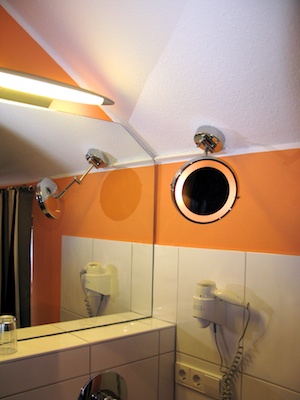When using devices for some length of time, we tend to get used to their idiosyncrasies and develop ways to work around any design details that may have stumped us at first. Therefore, staying at hotels provides great opportunities for observing the use of simple, everyday things like door handles, light switches, TV remotes, etc., because their designs may differ enough from what we use in our own homes that we can gain some insightful first-usage impressions.
As an example, on a recent trip I noticed this interesting makeup mirror. The ring of frosted glass gives a clue that there might be a light in the mirror, but there is no visible power switch to be found.

Well, that’s not entirely true, because, as soon as you touch the mirror — e.g., by running your fingers along its surface in search of that switch — you will realize that the mirror’s chrome enclosure is the switch: it’s touch-sensitive! So, in a way, the switch is “highly visible” after all.
Due to the total lack of visual clues (and instructional notes near the mirror), however, it is just not obvious that the mirror’s light works in this manner. In other words, the device does not support the user in understanding how it is operated at all, making accidental discovery of the light switch the norm.
What’s more, the light does not only toggle between on and off, but offers three brightness levels. Touching the surface cycles through these three levels and the off state, so to switch it off, you may have to tap the mirror several times.
Worse yet, when you adjust the mirror to see yourself in it, you will, of course, change the light’s setting every time you touch the mirror’s enclosure.
A four-state switch placed on the mirror’s front panel would easily solve all four of the mirror’s usability problems:
- provide a visual clue beyond the frosted glass ring that there is a light in the mirror,
- make it easy to discover how to operate this light,
- visual indicate how many settings there are,
- make switching the light off a one-tap operation at all times, and
- allow adjusting the mirror without also affecting the light.
And, of course, it could “even” be implemented in the form of four closely-grouped touch-sensor pads to demonstrate that the manufacturer’s engineering department knows how to master this technology…
By giving visual appearance a higher priority over usability, the designers may have achieved to create a cleaner-looking, more elegant makeup mirror. But every day, countless hotel guests pay the price for this decision by standing in front of that mirror, scratching their heads and wondering how to switch on that darned light.